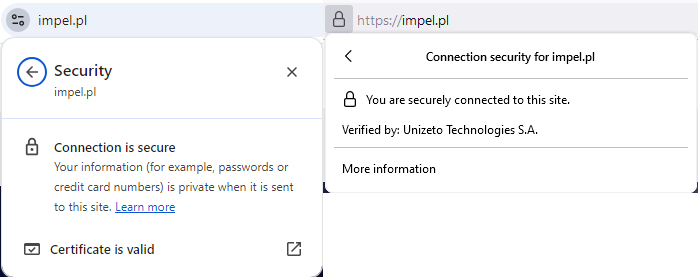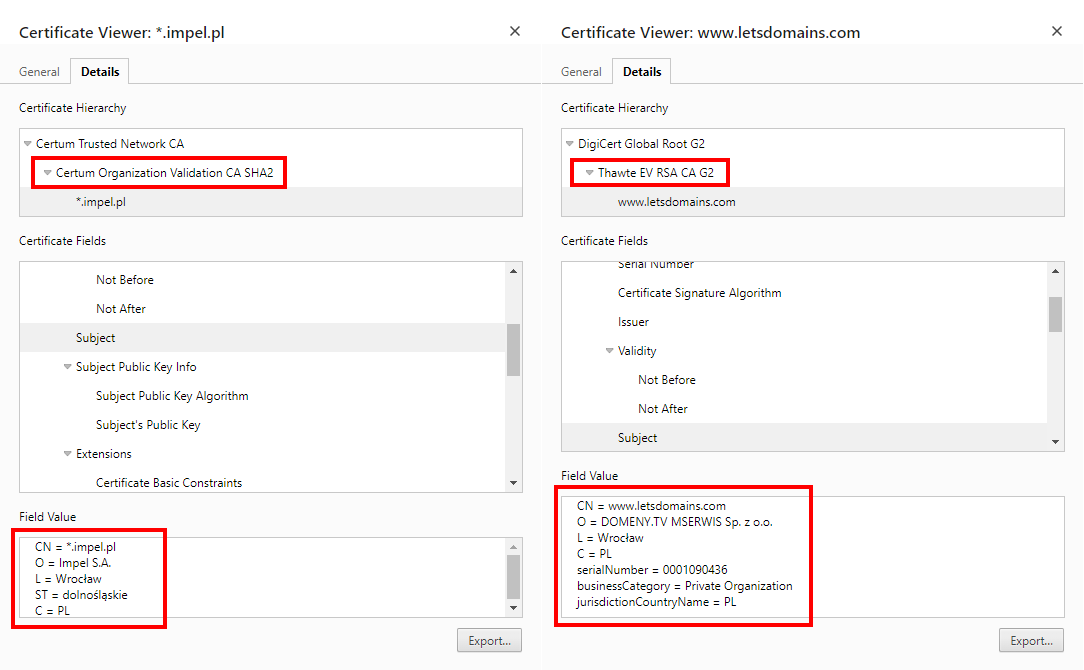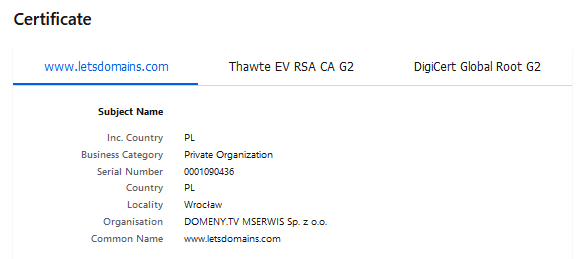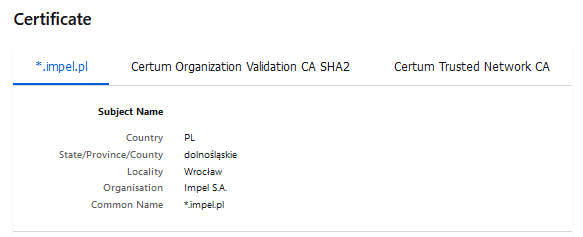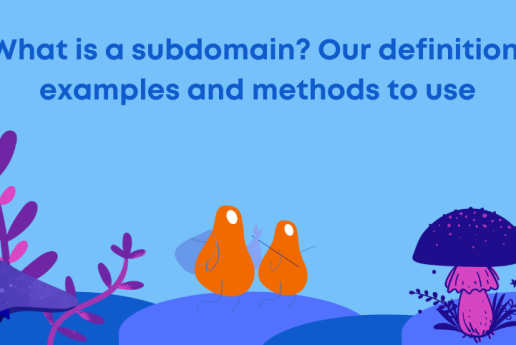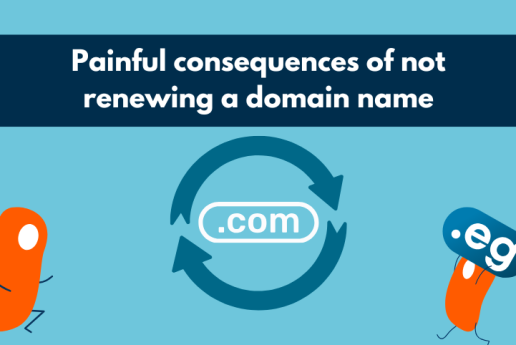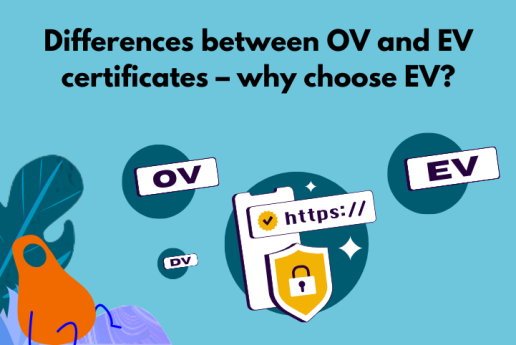Differences between OV and EV certificates – why choose EV?

SSL certificates are divided into three types of validation: DV (Domain Validation), OV (Organization Validation), and EV (Extended Validation). Each offers different levels of verification and trust, which is important for both website owners and their users.
On the internet, you can find a lot of general and incomplete information about the security levels provided by different validations and the procedures required to obtain them. However, it's rare to come across precise information about the benefits and impact these certificates have on you as a website owner and your users.
In this article, you will find a detailed discussion of the attributes of OV and EV SSL certificates. You'll understand how different validation levels affect the security and trust of your users on your website. You'll also learn the key differences between OV and EV. Discover how to enhance protection against phishing attacks. And most importantly, you'll understand what truly distinguishes EV certificates and why they are worth the investment.
Types of SSL validation: DV, OV, and EV – differences
SSL certificate validation is the process of confirming that the domain or organization owner is authentic and has the right to the certificate. SSL certificates are divided into three types of validation: DV (Domain Validation), OV (Organization Validation), and EV (Extended Validation). Each offers different levels of verification and trust, which is important for both website owners and their users.
In this article, we’ll take a closer look at OV and EV SSL certificates and the differences between them.
DV certificates (Domain Validation)
The first and simplest type of validation is the DV certificate. The verification process only involves checking whether you control the domain. The procedure is fast and doesn’t require documentation. DV certificates encrypt the connection but do not provide information about your organization.
OV certificates (Organization Validation)
OV certificates verify both domain control and the existence of your organization. To obtain an OV certificate, you must provide documents proving the existence of the organization, which takes longer than DV validation. With OV certificates, your users will see information about the organization in the certificate properties, which increases their trust in your website.
OV certificates provide additional protection against phishing attacks by allowing customers to verify the organization’s details in the certificate properties. However, they do not offer the same level of detailed verification or display the company name after clicking the lock or padlock icon in browsers like EV certificates do. OV certificates are suitable for most business websites.
EV Certificates (Extended Validation) – differences from OV
EV certificates offer the highest level of trust and security. To obtain an EV certificate, you must go through the most stringent verification process, which includes thorough checks of the legal, physical, and operational existence of your organization. EV certificates provide the most information about the organization, including additional fields in the certificate details, which we will discuss in detail later. This is the best solution for large companies, e-commerce, banks, and other websites requiring the highest level of trust.
EV certificates provide an additional layer of protection through the most rigorous verification, offering more detailed information embedded in the certificate about the company than OV certificates. This makes it much harder for fraudsters to impersonate legitimate websites, as more detailed and harder-to-fake information is required. As a result, users can more easily verify the website’s credibility, increasing their trust and sense of security when using the site.
EV certificates display the organization’s name after clicking the padlock or tune icon in the browser’s address bar, which is easily recognizable by users. In the past, this also included a green address bar. This indicator increases users’ trust in the website, which is not offered by OV certificates.
Trust and visibility attributes of verified organizational data in EV certificates in Chrome (left) and Mozilla Firefox (right).
Trust and visibility attributes of verified organizational data in OV certificates in Chrome (left) and Mozilla Firefox (right).
EV certificates often provide higher warranty amounts in cases of security breaches, such as unauthorized data access or man-in-the-middle attacks, compared to OV certificates. For example, with SECTIGO certificates, the OV variant offers a $50,000 warranty, while the EV variant provides up to $1,750,000.
How to check the validation level of a given SSL certificate?
You can check the validation levels of SSL certificates (DV, OV, EV) in a few simple steps, regardless of the browser you’re using. Below are the steps for checking this in two of the most popular browsers: Chrome and Mozilla Firefox.
Checking SSL certificate type and validation level in Chrome
- Open the website whose certificate you want to check and click the padlock icon on the left side of the URL bar.
- Select the option "Connection is secure" and then click "Certificate (Valid)".
- A new window with certificate information will open. You can check the certificate type in the "General" tab under the field "Issued by".
- Additionally, in the "Details" tab, you will find all the attributes (properties) of the SSL certificate, including the "Issuer" field, where you can also find information about the certificate type.
- You can determine the type of certificate by reviewing the details in the "Details" tab under the "Subject" field:
- OV Certificate – You'll find basic information like "Organization", "Country", "State", "City".
- EV Certificate – Additional fields like "Serial number", "Business category", "Registered country", "State", and "Region" will be displayed.
Example of a certificate with OV and EV validation in Chrome
Checking SSL Certificate type and validation level in Mozilla Firefox
- Open the website whose certificate you want to check and click the padlock icon on the left side of the URL bar.
- Choose "Connection Secure" from the dropdown menu, then "More information".
- In the new window, go to the "Security" tab and click "View Certificate."
- A new window with certificate information will open. You can check the certificate type in the "Issuer Name" column.
- To determine the type of certificate, check the "Subject Name" column:
-
- OV Certificate – Here, you will see basic information such as "Country," "State," "Region," "Organization," and "Common Name."
- EV Certificate – In this case, you will see additional fields such as "Registered Country," "Business Category," and "Serial Number."
Example of a certificate with EV validation in the Mozilla Firefox browser.
Example of a certificate with OV validation in the Mozilla Firefox browser.
Differences in organization information in OV and EV certificates in Chrome
OV and EV certificates differ in the level of detail about the organization they secure. In an EV certificate, you’ll find additional fields not present in OV certificates because EV certificates require a more rigorous verification process.
Explanation of the “Subject” field in certificate details
In the “Subject” field for both OV and EV certificates, you’ll find detailed information about the organization, such as:
- CN (Common Name) – the primary name, typically the fully qualified domain name (FQDN) for which the certificate was issued. This field identifies the domain secured by the SSL certificate.
- O (Organization) – the name of the organization to which the certificate was issued. This field indicates the legally registered name of the certificate holder's organization.
- OU (Organizational Unit) – the division or department within the organization responsible for the certificate. This field can specify a particular department, such as the IT department.
- L (Locality) – the city where the organization is located.
- ST (State or Province) – the state or province where the organization is registered.
- C (Country) – the country where the organization is registered.
Explanation of additional fields in EV certificate attributes
For EV certificates, you’ll find additional fields:
- serialNumber – the organization’s registration number. This additional information helps to uniquely identify the organization, especially for large companies managing multiple certificates.
- businessCategory – the category of the business, which can be specified as “Private Organization,” “Government Entity,” “Business Entity,” or “Non-commercial Entity.”
- jurisdictionCountryName – indicates the country in which the organization is legally registered.
- jurisdictionStateOrProvinceName – (if applicable) the state or province in which the organization is legally registered.
Why is detailed organization information present in EV but not in OV?
EV certificates are designed to provide the highest level of trust and security, which is particularly important for sites such as banks, e-commerce platforms processing large amounts of customer data, HR services handling employee information, medical services, and other organizations requiring a high level of security. EV certificates undergo more detailed verification than OV certificates and contain more information to ensure that users can fully trust the website’s identity. This includes checking the company’s legal registration, physical location, and authorization to operate in the given jurisdiction.
Conclusion – why choose an EV certificate?
SSL certificates are divided into three types of validation: DV, OV, and EV. DV certificates are the simplest, verifying only domain control but not providing information about the organization.
OV certificates verify both domain control and the existence of the organization. They require documents proving the company’s existence and verification by the certificate issuer’s employee. With OV certificates, users can see organization details such as name, country, state, and city in the certificate properties, increasing trust in the website.
EV certificates provide the highest level of trust and security through the most rigorous verification process, which includes thorough checks of the organization’s legal and operational existence. They provide the most information about the organization, including additional data like the company’s registration number, business type, and country of incorporation. This makes EV certificates harder to counterfeit, helping users recognize legitimate sites and providing additional protection against phishing attacks.
EV certificates display the organization’s name in the browser’s address bar, significantly increasing user trust. They often provide higher warranty amounts than OV in cases of security breaches, offering greater financial support from the certificate issuer.
Remember: As a user, you are vulnerable to attacks when you mistakenly believe that encryption alone guarantees full security. For your safety, you should know that you can check SSL certificate details and verify the authenticity of websites. This can protect you from unpleasant consequences.
Ensure the highest level of security and trust for your users, and order an EV or OV certificate today.
FAQ – OV vs. EV certificates
1. What is the main difference between OV and EV SSL certificates?
OV verifies organization details but shows limited data in the certificate. EV includes extended verification and displays more legal and business information, boosting user trust.
2. Do EV certificates still show the green address bar?
Not anymore. Modern browsers show the company name in certificate details when clicking the padlock icon, but the green bar was removed for UI simplification.
3. Are EV certificates harder to get?
Yes. They require strict documentation, including proof of legal existence, physical address, and operational status.
4. Which websites should use EV certificates?
Banks, e-commerce sites, healthcare services, HR portals, and any business handling sensitive user data should strongly consider EV.
5. Are EV certificates worth the extra cost?
Yes. They provide higher trust, stronger phishing protection, and larger warranty coverage compared to OV.
I am promoting our services, products, and software. I work closely with the development and support teams, create campaigns and content, manage social media, and translate complex technical concepts into clear communication for our customers.


